
Lobelia purpurascens, commonly known as white root or purplish pratia, is a flowering plant in the family Campanulaceae of eastern Australia. It is a small herbaceous, scrambling plant with white to pale pink flowers.

Goodenia montana, commonly known as mountain velleia, is a flowering plant in the family Goodeniaceae. It is a small, perennial herb with tubular yellow flowers, mainly growing in woodland and sub-alpine grasslands in New South Wales, Victoria and Tasmania.
Leptorhynchos is a genus of annual or perennial herbs in the family Asteraceae. All species are endemic to Australia.

Scaevola hookeri, commonly known as the creeping fan-flower or alpine fan-flower, is a species of flowering plant in the family Goodeniaceae. It has white or blue flowers with a yellow throat and grows in eastern Australia.

Lobelia anceps, commonly known as angled lobelia, is a small herbaceous plant in the family Campanulaceae it grows in several states of Australia, New Zealand, South America and South Africa. It is a small, perennial herb with blue to purple flowers.

Goodenia heterophylla is a species of plant in the family Goodeniaceae and is endemic to eastern Australia. It is an erect to trailing, more or less woody herb or shrub with linear to egg-shaped stem-leaves and racemes or thyrses of yellow flowers.

Brachyscome aculeata, commonly known as hill daisy, is a tufted perennial herb in the family Asteraceae and is endemic to Australia. It has mostly white daisy-like flowers, a yellow centre, variable shaped leaves and flowers in spring to autumn.
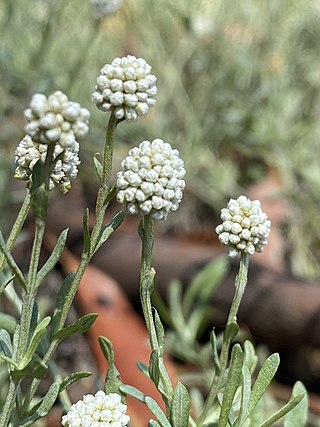
Calocephalus lacteus, commonly known as milky beauty-heads, is a species of flowering plant in the family Asteraceae. It is an ascending, spreading perennial with silver-grey leaves and cream globular-shaped flower heads. It occurs in eastern Australia.
Scaevola collina, is a species of flowering plant in the family Goodeniaceae. It is a small sub-shrub with blue to purplish flowers. It grows in South Australia.

Scaevola parvibarbata is a species of flowering plant in the family Goodeniaceae. It is an upright herb with fan-shaped mauve or greenish flowers and grows in New South Wales, Queensland, South Australia and the Northern Territory.
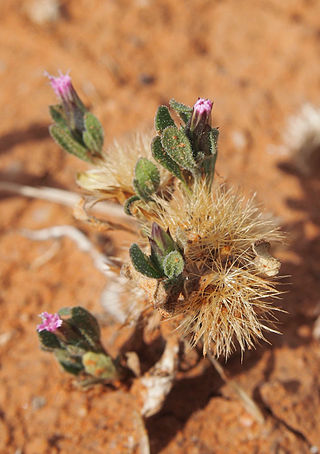
Streptoglossa adscendens, commonly known as desert daisy, is a species of flowering plant in the family Asteraceae and grows in all mainland states of Australia with the exception of Victoria. It is a ground cover, upright or ascending perennial or annual herb with purple or pink flowers.

Streptoglossa bubakii is a species of flowering plant in the family Asteraceae and grows in Queensland, Western Australia and the Northern Territory. It is an upright, aromatic perennial herb with pink, purplish-blue or red to brown flowers.

Streptoglossa odora is a species of flowering plant in the family Asteraceae. It is a spreading, perennial herb with pink or bluish-purple flowers. It grows in Queensland, Western Australia and the Northern Territory.
Streptoglossa tenuiflora is a species of flowering plant in the family Asteraceae. It is an upright perennial or annual herb with pink to purple flowers. It is endemic to Western Australia.
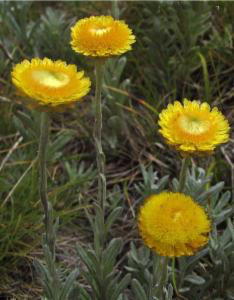
Coronidium monticola, commonly known as the mountain coronidium, is a flowering plant in the family Asteraceae and grows in open forests in eastern Australia. It has woolly, grey-green leaves and mostly yellow flowers.

Calocephalus lacteus, commonly known as lemon beauty-heads, is a species of flowering plant in the family Asteraceae. It has yellow cylindrical shaped flowers and grey stems and grows in the eastern states of Australia

Brachyscome spathulata, commonly known as spoon-leaved daisy, is a flowering plant in the family Asteraceae. It has dark green leaves, mauve daisy-like flowers and grows in New South Wales, Tasmania, Victoria and the Australian Capital Territory.
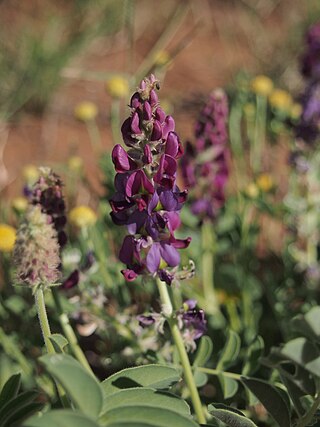
Swainsona canescens, commonly known as grey swainsona, is a flowering plant in the family Fabaceae. It is a small perennial herb with pink-purple or purple, yellow and green flowers and grows in Queensland, Western Australia and South Australia.

Calocephalus platycephalus commonly known as western beauty-heads or yellow top, is a species of flowering plant in the family Asteraceae. It is an upright to sprawling herb with white hairy foliage and yellow ball-shaped flower heads and is endemic to Australia.
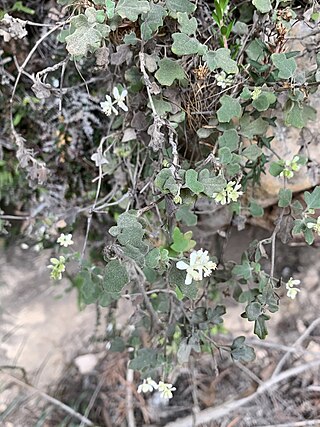
Xanthosia scopulicola is a species of flowering plant in the family Apiaceae and is endemic to a small area of New South Wales. It is an ascending perennial subshrub with trifoliate juvenile leaves, later egg-shaped leaves with wavy edges, and white flowers in a compound umbel with 2 or 3 rays with up to 4 flowers in each ray.

















